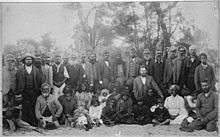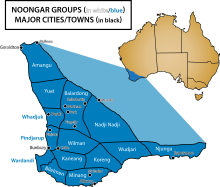Fanny Balbuk
Fanny Balbuk (1840-1907) was a prominent Noongar Whadjuk woman who lived in Perth, Western Australia during the early years of the Swan River Colony. Balbuk (sometimes recorded as "Yooreel") was born on Heirisson Island in the Swan River,[1] and her country included the swamps and wetland in the area currently occupied by the Perth Railway Station and Perth Cultural Centre. She is remembered for her fierce commitment to land rights, and her reactions to the buildings, fences and homes which quickly replaced her land as the colony expanded at the cost of Noongar peoples' land, language and lives.[2]

Early life
Balbuk was born to Joojeebal (Doodyep) and Coondenung on Heirisson Island in 1840. Her father Coondenung was an accomplished hunter and her mother Joojeebal was known for "cheeky" sense of humour.[3]
Life
Balbuk was born near the causeway on Noongar Whadjuk country, and would collect Gilgies and vegetables from the swampy areas around Perth. She was a descendant of Yellagonga and her traditional country covers the Perth central business district area.

Balbuk was well known among the colonists who had grown up around her. At a young age she had travelled around to places like Northam, Moore River and Dandaragan, and attended a friendship ceremony where she was given the name Yooreel at Moore River. She was remembered for her unwavering commitment to maintaining her land rights in the earliest days of the frontier wars in Western Australia. Balbuk would walk the track between her birth site and the railway station, regardless of any new obstacles, buildings or fences which would spring up in her path as the colony grew. Daisy Bates herself wrote "one of her favourite annoyances was to stand at the gates of Government House, reviling all who dwelt within, in that the stone gates guarded by a sentry enclosed her grandmother's burial ground."[4]
Noongar Elder Noel Nannup tells a similar story: "That was her songline, her dreaming. She just kept going and didn’t take any notice of the new city going up. That’s a story of defiance and determination."[5]
Death
Balbuk died in 1907,[6] leaving no descendants.
References
- national museum of australia First Australians
- "Fanny Balbuk Yooreel". Nyoongar Tent Embassy. Retrieved 19 September 2015.
- "First Australians: Fanny Balbuk". National Museum of Australia. National Museum of Australia. Retrieved 19 September 2015.
- Bates, Daisy (2004). My natives and I. Hesperian Press. p. 65.
- "Fighting for families, Country, rights and recognition" (PDF). City of Perth. City of Perth. Retrieved 19 September 2015.
- Bates, Daisy (1 June 1907). "Fanny Balbuk-Yooreel". The Western Mail. p. 44. Retrieved 19 September 2015.